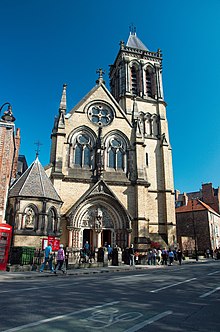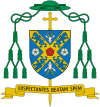
The Cathedral Church of St Peter and St Wilfrid, commonly known as Ripon Cathedral, and until 1836 known as Ripon Minster, is a cathedral in Ripon, North Yorkshire, England. Founded as a monastery by monks of the Irish tradition in the 660s, it was refounded as a Benedictine monastery by St Wilfrid in 672. The church became collegiate in the tenth century, and acted as a mother church within the large Diocese of York for the remainder of the Middle Ages. The present church is the fourth, and was built between the 13th and 16th centuries. In 1836 the church became the cathedral for the Diocese of Ripon. In 2014 the Diocese was incorporated into the new Diocese of Leeds, and the church became one of three co-equal cathedrals of the Bishop of Leeds.

Brompton Oratory, also known as the London Oratory, is a neo-classical late-Victorian Roman Catholic parish church in the Brompton area of the Royal Borough of Kensington and Chelsea, neighbouring Knightsbridge, London. The name The Oratory stems from the religious order, the Oratorians who own the building and service the parish. The church's formal title is the Church of the Immaculate Heart of Mary. Its Grade II* architectural listing refers to it as "The Oratory". The Oratorian priests there celebrate Mass daily in both the Ordinary and Extraordinary forms. Due to its location and character, the church attracts expatriate worshippers and visitors from many countries. After World War II, it temporarily hosted the parish of the Polish diaspora in London. The church has a reputation for the quality of its Liturgical music and the notable musicians who perform there, among them, the late Ralph Downes. There are three choirs at the church. The London Oratory School in the nearby London Borough of Hammersmith and Fulham is closely connected to the church, having been founded by the Oratorians.

St George's Roman Catholic church is located in the centre of the city of York, England, on George Street in the Diocese of Middlesbrough. The Church was designed by Joseph Hansom and was the first pro-Cathedral of the Diocese of Beverley.
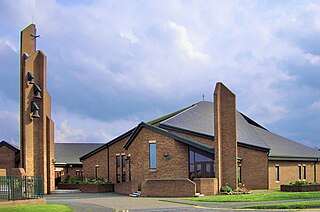
Saint Mary's Cathedral, also known as Middlesbrough Cathedral, is a Roman Catholic cathedral in Coulby Newham, Middlesbrough, England. It is the see of the Bishop of Middlesbrough, who is ordinary of the Diocese of Middlesbrough in the Province of Liverpool.
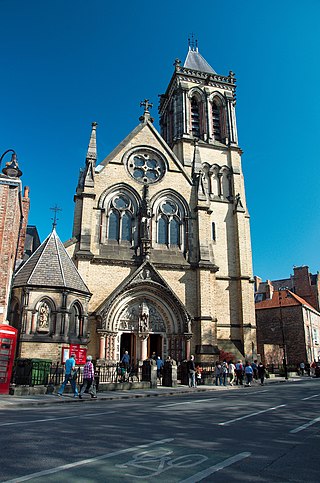
George Goldie was an English ecclesiastical architect who specialised in Roman Catholic churches.

Margaret Clitherow was an English saint and martyr of the Roman Catholic Church, known as "the Pearl of York". She was pressed to death for refusing to enter a plea to the charge of harbouring Catholic priests. She was canonised in 1970 by Pope Paul VI.
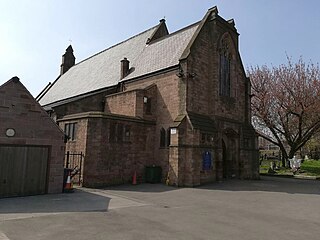
St Bede's Church is a Roman Catholic parish church in Rotherham, South Yorkshire, England. The Gothic Revival style church, designed by Weightman and Hadfield, is situated on the corner of Station Road and St Bede's Road in Masbrough near the town centre. Built from 1841 to 1842, it was opened eight years before the Restoration of the English hierarchy in 1850.
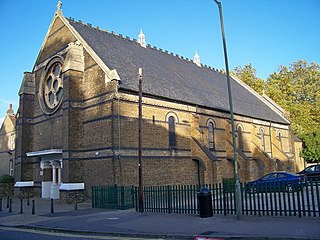
St Michael the Archangel Church is a Roman Catholic parish church in Chatham, Kent, England. It was built from 1862 to 1863 in the Romanesque Revival style, designed by Henry Clutton. In 1935, an extension was built, designed by the Frederick Walters and Son firm. It is situated on Hill's Terrace between Rochester Street and Maidstone Road, next to Chatham railway station. When built, it was the only Catholic church in Medway.

St Joseph's Church is a Roman Catholic Parish church in Stockport, Greater Manchester, England. It was built from 1861 to 1862 and designed by Matthew Ellison Hadfield. It is situated on St Petersgate, south west of the High Street. It is the only church in England administered by the Priests of the Sacred Heart and is a Grade II listed building.

Duncombe Place is a street in the city centre of York, in England.

Petergate is a street in the city centre of York, in England. It is divided into High Petergate and Low Petergate. The well-known view of the Minster from Low Petergate is described by the City of York Council as "excellent".

More House is the Catholic chaplaincy for the University of York in Heslington, York. The building itself dates from the late 18th century. The chaplains were formerly Carmelite friars resident in the building, but since 2021 priests from York Oratory have been ministering to the chaplaincy. It is located on Main Street in Heslington, which is towards the south edge of the university's Campus West. It is a Grade II listed building.

St Mary's Church is a Roman Catholic Parish church in Hexham, Northumberland. It was built from 1828 to 1830 in the Gothic Revival style. It is located on Battle Hill, opposite Hexham Park, close to the town centre. It is a Grade II* listed building.

St Mary's Church is a Roman Catholic parish church in Stockton-on-Tees, County Durham, England. It was built in 1842 and designed by Augustus Pugin in the Gothic Revival style. According to Historic England, the current building was first permanent Roman Catholic church to be built in Teesside since the Reformation. It is located in the town centre, on the corner of Norton Road and Major Street, with the A1305 road to the north of it. It is a Grade II listed building.

St Wilfrid's Church is a Roman Catholic parish church in Ripon, North Yorkshire, England. It was built from 1860 to 1862 and designed by Joseph Hansom. It is located on the corner of Trinity Lane and Coltsgate Hill to the north of the centre of Ripon. It is in the Gothic Revival style and is a Grade II* listed building.

Our Lady and St Peter's Church is a Roman Catholic parish church in Bridlington, East Riding of Yorkshire, England. It was built from 1893 to 1894 in the Gothic Revival style. It is located on the corner of Victoria Road and Wycliffe Lane, close to the town centre. It is a Grade II listed building.

St John of Beverley Church is a Roman Catholic parish church in Beverley, East Riding of Yorkshire, England. It was built from 1897 to 1898 in the Gothic revival style. It is located on the corner of York Street and the North Bar in the centre of the town. It is a Grade II listed building.
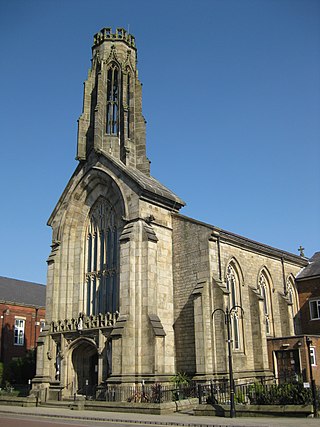
St Marie's Church is a Roman Catholic parish church in Bury, Greater Manchester, England. It was built from 1841 to 1842 in the Gothic Revival style. It is situated between the Manchester Road and Back Knowsley Street in the town centre. It is a Grade II listed building.

St Mary's Church or St Mary Immaculate Church is a Roman Catholic parish church in Falmouth, Cornwall, England, United Kingdom. It was built from 1868 to 1869 and designed by Joseph Hansom. The architecture of the church, according to Historic England is a blend of "Gothic and Burgundian Romanesque styles". It is located on the corner of Kimberley Place and Killigrew Street. It was extended by Hansom's son Joseph Stanislaus Hansom in 1881 and it is a Grade II listed building.
